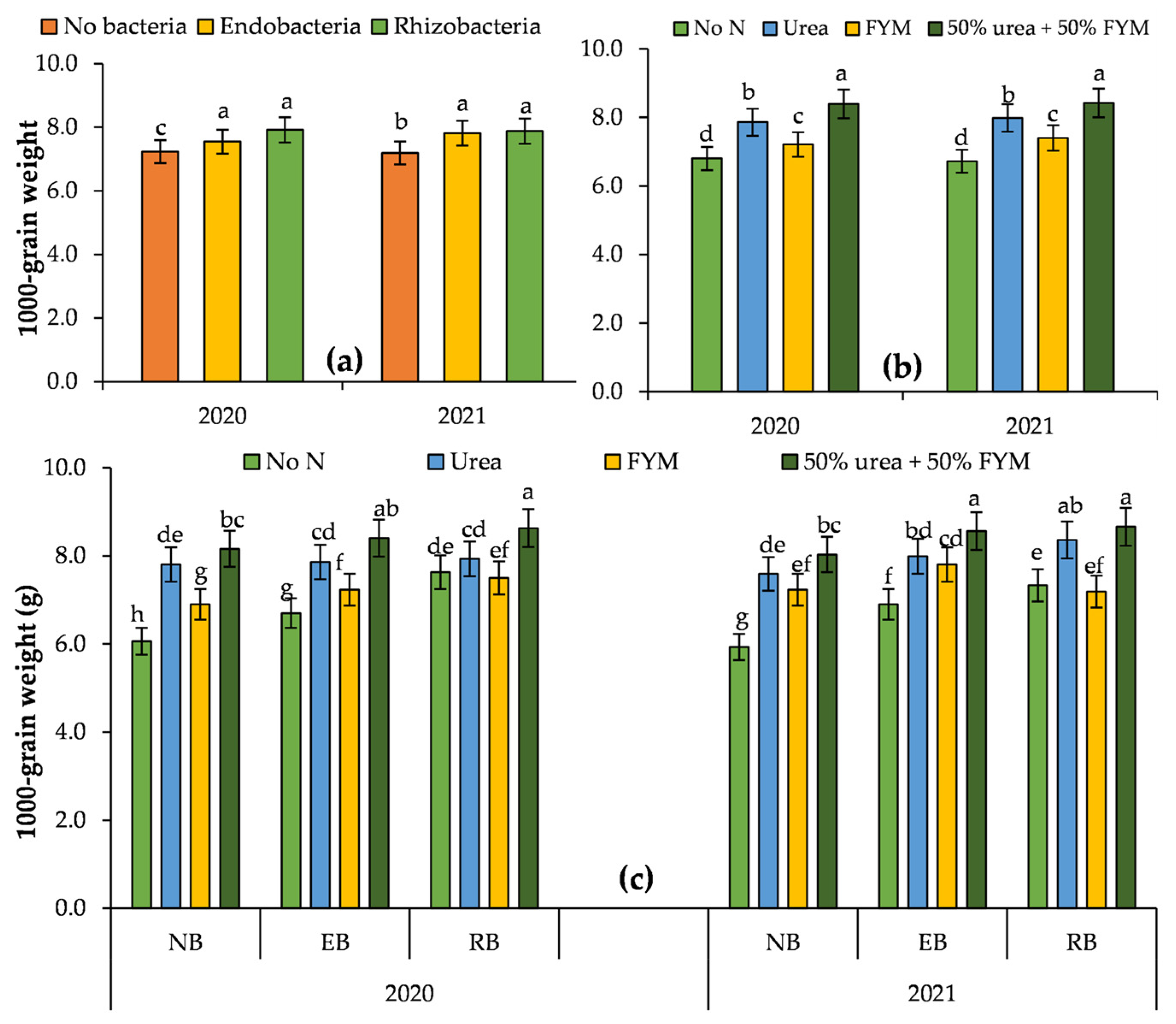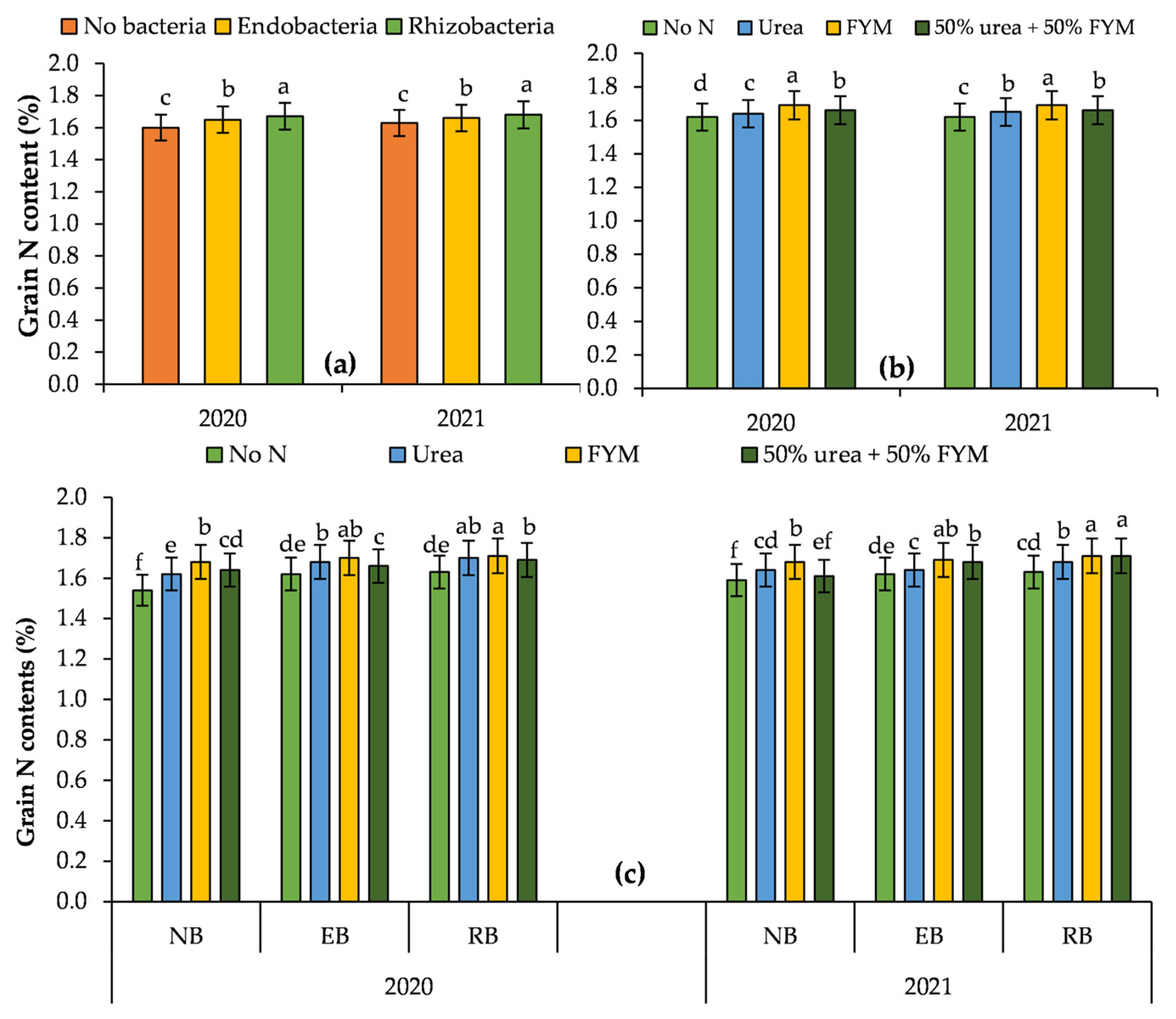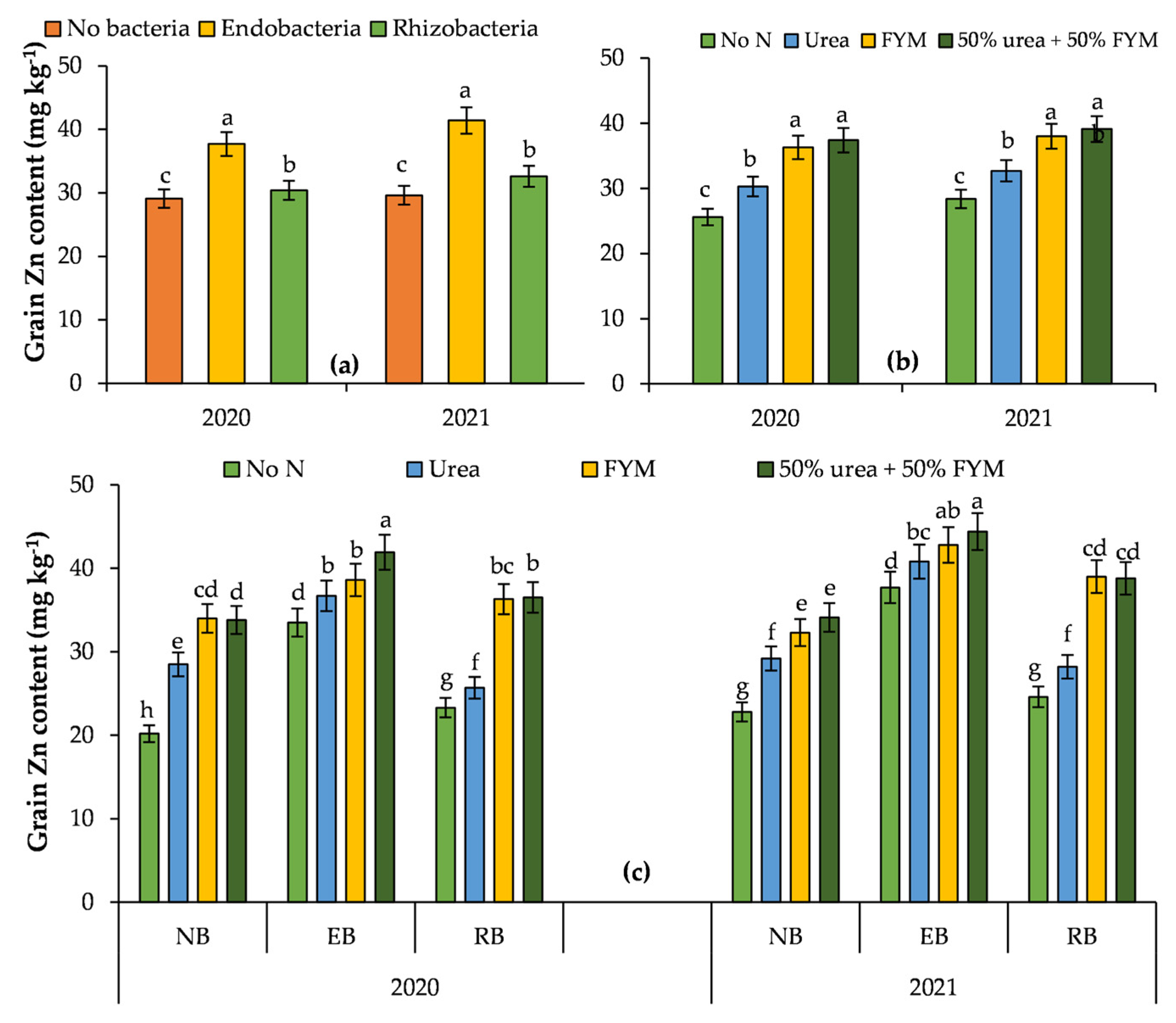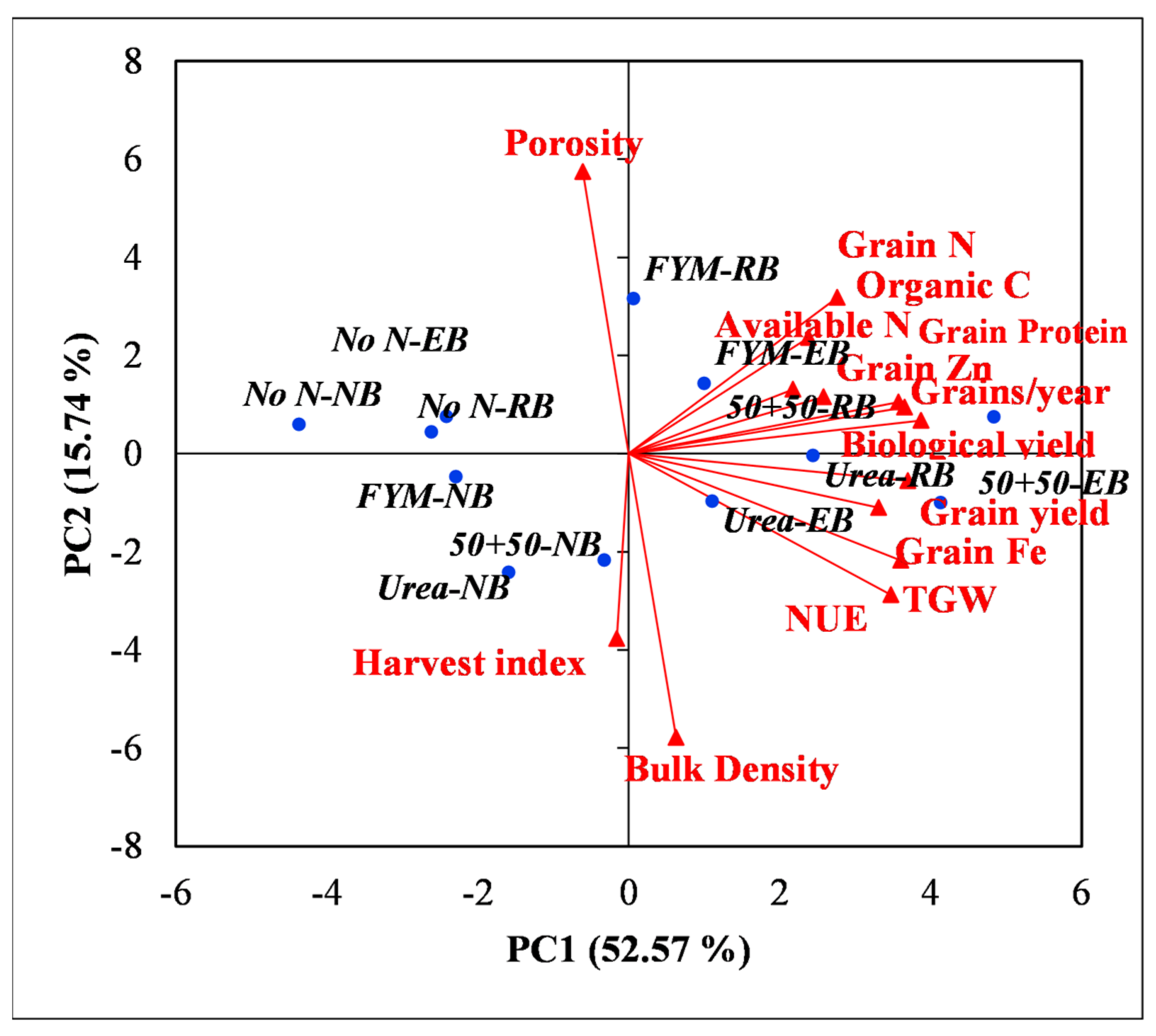Combined Application of Organic and Inorganic Nitrogen and Seed Inoculation with Rhizobacteria (Stenotrophomonas maltophilia FA-9) Improved Productivity, Nitrogen Use Efficiency, and Economic Returns of Pearl Millet
Abstract
1. Introduction
2. Materials and Methods
2.1. Experimental Site
2.2. Soil and Weather Attributes
2.3. Treatment Details
2.4. Crop Husbandry
2.5. Data Collection
2.5.1. Soil Properties
2.5.2. Yield-Related Parameters
2.5.3. Grain Nutrient Analysis
2.5.4. Nitrogen Use Efficiency (NUE)
2.6. Statistical and Economic Analysis
3. Results
3.1. Soil Properties
3.2. Yield and Related Traits
3.3. Grain Quality Parameters
3.4. Nitrogen Use Efficiency
3.5. Multivariate Analysis
3.6. Economic Analysis
4. Discussion
5. Conclusions
Supplementary Materials
Author Contributions
Funding
Institutional Review Board Statement
Informed Consent Statement
Data Availability Statement
Conflicts of Interest
References
- Reddy, P.S.; Satyavathi, C.T.; Khandelwal, V.; Patil, H.T.; Gupta, P.C.; Sharma, L.D.; Mungra, K.D.; Singh, S.P.; Narasimhulu, R.; Bhadarge, H.H.; et al. Performance and Stability of Pearl Millet Varieties for Grain Yield and Micronutrients in Arid and Semi-Arid Regions of India. Front. Plant Sci. 2021, 12, 670201. [Google Scholar] [CrossRef] [PubMed]
- Hassan, Z.M.; Sebola, N.A.; Mabelebele, M. The Nutritional Use of Millet Grain for Food and Feed: A Review. Agric. Food Secur. 2021, 10, 16. [Google Scholar] [CrossRef] [PubMed]
- Asmare, B.; Demeke, S.; Tolemariam, T.; Tegegne, F.; Haile, A.; Wamatu, J. Effects of Altitude and Harvesting Dates on Morphological Characteristics, Yield and Nutritive Value of Desho Grass (Pennisetum pedicellatum Trin.) in Ethiopia. Agric. Nat. Resour. 2017, 51, 148–153. [Google Scholar] [CrossRef]
- Yadav, R.S.; Sehgal, D.; Vadez, V. Using genetic mapping and genomics approaches in understanding and improving drought tolerance in pearl millet. J. Exp. Bot. 2011, 62, 397–408. [Google Scholar] [CrossRef] [PubMed]
- Pattanashetti, S.K.; Upadhyaya, H.D.; Dwivedi, S.L.; Vetriventhan, M.; Reddy, K.N. Pearl Millet. In Genetic and Genomic Resources for Grain Cereals Improvement; Elsevier: Amsterdam, The Netherlands, 2016; pp. 253–289. [Google Scholar]
- GOP. Economic Survey of Pakistan; Economic Advisory Wing: Islamabad, Pakistan, 2021. [Google Scholar]
- Majeed, A.; Farooq, M.; Naveed, M.; Hussain, M. Combined Application of Inorganic and Organic Phosphorous with Inoculation of Phosphorus Solubilizing Bacteria Improved Productivity, Grain Quality and Net Economic Returns of Pearl Millet (Pennisetum glaucum [L.] R. Br.). Agronomy 2022, 12, 2412. [Google Scholar] [CrossRef]
- Pujarula, V.; Pusuluri, M.; Bollam, S.; Das, R.R.; Ratnala, R.; Adapala, G.; Thuraga, V.; Rathore, A.; Srivastava, R.K.; Gupta, R. Genetic Variation for Nitrogen Use Efficiency Traits in Global Diversity Panel and Parents of Mapping Populations in Pearl Millet. Front. Plant Sci. 2021, 12, 625915. [Google Scholar] [CrossRef]
- FAO. World Fertilizer Trends and Outlook to 2020; FAO: Rome, Italy, 2020. [Google Scholar]
- Núñez, P.A.; Demanet, R.; Misselbrook, T.H.; Alfaro, M.; Mora, M.d.l.L. Nitrogen Losses under Different Cattle Grazing Frequencies and Intensities in a Volcanic Soil of Southern Chile. Chil. J. Agric. Res. 2010, 70, 237–250. [Google Scholar] [CrossRef]
- Singh, A.; Maji, S.; Kumar, S. Effect of Biofertilizers on Yield and Biomolecules of Anti-Cancerous Vegetable Broccoli. Int. J. Bio-Resour. Stress Manag. 2014, 5, 262. [Google Scholar] [CrossRef]
- Raun, W.R.; Johnson, G. V Improving Nitrogen Use Efficiency for Cereal Production. Agron. J. 1999, 91, 357–363. [Google Scholar] [CrossRef]
- Fan, X.; Zhang, S.; Mo, X.; Li, Y.; Fu, Y.; Liu, Z. Effects of Plant Growth-Promoting Rhizobacteria and N Source on Plant Growth and N and P Uptake by Tomato Grown on Calcareous Soils. Pedosphere 2017, 27, 1027–1036. [Google Scholar] [CrossRef]
- Begizew, G. Role of Integrated Nutrient Management for Enhancing Nitrogen Use Efficiency in Crop. Open J. Plant Sci. 2020, 5, 1–12. [Google Scholar] [CrossRef]
- Bhatt, M.; Singh, A.P.; Singh, V.; Kala, D.C.; Kumar, V. Long-Term Effect of Organic and Inorganic Fertilizers on Soil Physico-Chemical Properties of a Silty Clay Loam Soil under Rice-Wheat Cropping System in Tarai Region of Uttarakhand. J. Pharmacogn. Phytochem. 2019, 8, 2113–2118. [Google Scholar]
- Tiwari, A.; Singh, N.B.; Kumar, A. Effect of Integrated Nutrient Management (INM) on Soil Properties, Yield and Economics of Rice (Oryza sativa L.). Res. J. Env. Life Sci. 2017, 10, 640–644. [Google Scholar]
- Ul-Allah, S.; Khan, A.A.; Fricke, T.; Buerkert, A.; Wachendorf, M. Fertilizer and Irrigation Effects on Forage Protein and Energy Production under Semi-Arid Conditions of Pakistan. Field Crops Res. 2014, 159, 62–69. [Google Scholar] [CrossRef]
- Ul-Allah, S.; Khan, A.A.; Fricke, T.; Buerkert, A.; Wachendorf, M. Effect of Fertiliser and Irrigation on Forage Yield and Irrigation Water Use Efficiency in Semi-Arid Regions of Pakistan. Exp. Agric. 2015, 51, 485–500. [Google Scholar] [CrossRef]
- Shaji, H.; Chandran, V.; Mathew, L. Organic Fertilizers as a Route to Controlled Release of Nutrients. In Controlled Release Fertilizers for Sustainable Agriculture; Elsevier: Amsterdam, The Netherlands, 2021; pp. 231–245. [Google Scholar]
- Li, H.-B.; Singh, R.K.; Singh, P.; Song, Q.-Q.; Xing, Y.-X.; Yang, L.-T.; Li, Y.-R. Genetic Diversity of Nitrogen-Fixing and Plant Growth Promoting Pseudomonas Species Isolated from Sugarcane Rhizosphere. Front. Microbiol. 2017, 8, 1268. [Google Scholar] [CrossRef]
- Glick, B.R. Plant Growth-Promoting Bacteria: Mechanisms and Applications. Scientifica 2012, 2012, 963401. [Google Scholar] [CrossRef] [PubMed]
- Paungfoo-Lonhienne, C.; Lonhienne, T.G.A.; Yeoh, Y.K.; Webb, R.I.; Lakshmanan, P.; Chan, C.X.; Lim, P.; Ragan, M.A.; Schmidt, S.; Hugenholtz, P. A New Species of B Urkholderia Isolated from Sugarcane Roots Promotes Plant Growth. Microb. Biotechnol. 2014, 7, 142–154. [Google Scholar] [CrossRef]
- Figueiredo, G.G.O.; Lopes, V.R.; Fendrich, R.C.; Szilagyi-Zecchin, V.J. Interaction between Beneficial Bacteria and Sugarcane. In Plant-Microbe Interactions in Agro-Ecological Perspectives; Springer: Singapore, 2017; pp. 1–27. [Google Scholar]
- Zhu, B.; Zhou, Q.; Lin, L.; Hu, C.; Shen, P.; Yang, L.; An, Q.; Xie, G.; Li, Y. Enterobacter Sacchari Sp. Nov., a Nitrogen-Fixing Bacterium Associated with Sugar Cane (Saccharum officinarum L.). Int. J. Syst. Evol. Microbiol. 2013, 63, 2577–2582. [Google Scholar] [CrossRef]
- Guo, D.-J.; Singh, R.K.; Singh, P.; Li, D.-P.; Sharma, A.; Xing, Y.-X.; Song, X.-P.; Yang, L.-T.; Li, Y.-R. Complete Genome Sequence of Enterobacter Roggenkampii ED5, a Nitrogen Fixing Plant Growth Promoting Endophytic Bacterium with Biocontrol and Stress Tolerance Properties, Isolated from Sugarcane Root. Front. Microbiol. 2020, 11, 580081. [Google Scholar] [CrossRef]
- Xing, Y.X.; Wei, C.Y.; Mo, Y.; Yang, L.T.; Huang, S.L.; Li, Y.R. Nitrogen-Fixing and Plant Growth-Promoting Ability of Two Endophytic Bacterial Strains Isolated from Sugarcane Stalks. Sugar Tech. 2016, 18, 373–379. [Google Scholar] [CrossRef]
- Hayat, R.; Ali, S.; Amara, U.; Khalid, R.; Ahmed, I. Soil Beneficial Bacteria and Their Role in Plant Growth Promotion: A Review. Ann. Microbiol. 2010, 60, 579–598. [Google Scholar] [CrossRef]
- Zewide, I. Role of Bio-Fertilizer for Maximizing Productivity of Selected Horticultural Crops. J. Agri. Res. Adv. 2019, 102, 1–18. [Google Scholar]
- Wilson, D. Endophyte: The Evolution of a Term, and Clarification of Its Use and Definition. Oikos 1995, 73, 274. [Google Scholar] [CrossRef]
- Lebeis, S.L. The Potential for Give and Take in Plant-microbiome Relationships. Front. Plant Sci. 2014, 5, 287. [Google Scholar] [CrossRef]
- Alexander, A.; Singh, V.K.; Mishra, A.; Jha, B. Plant Growth Promoting Rhizobacterium Stenotrophomonas Maltophilia BJ01 Augments Endurance against N2 Starvation by Modulating Physiology and Biochemical Activities of Arachis Hypogea. PLoS ONE 2019, 14, e0222405. [Google Scholar] [CrossRef]
- Park, M.; Kim, C.; Yang, J.; Lee, H.; Shin, W.; Kim, S.; Sa, T. Isolation and Characterization of Diazotrophic Growth Promoting Bacteria from Rhizosphere of Agricultural Crops of Korea. Microbiol. Res. 2005, 160, 127–133. [Google Scholar] [CrossRef]
- Berger, B.; Patz, S.; Ruppel, S.; Dietel, K.; Faetke, S.; Junge, H.; Becker, M. Successful Formulation and Application of Plant Growth-Promoting Kosakonia Radicincitans in Maize Cultivation. Biomed. Res. Int. 2018, 2018, 6439481. [Google Scholar] [CrossRef]
- Rashid, M.I.; Mujawar, L.H.; Shahzad, T.; Almeelbi, T.; Ismail, I.M.I.; Oves, M. Bacteria and Fungi Can Contribute to Nutrients Bioavailability and Aggregate Formation in Degraded Soils. Microbiol. Res. 2016, 183, 26–41. [Google Scholar] [CrossRef]
- Çağlar, Ö.; Bulut, S. Determination of Efficiency Parameters of Barley Inoculated with Phosphorous-Solubilizing and Nitrogen-Fixing Bacteria. Gesunde Pflanz. 2022, 1–9. [Google Scholar] [CrossRef]
- Bulut, S. Evaluation of Efficiency Parameters of Phosphorous-Solubilizing and N-Fixing Bacteria Inoculations in Wheat (Triticum aestivum L.). Turk. J. Agric. For. 2013, 37, 734–743. [Google Scholar] [CrossRef]
- Hameeda, B.; Rupela, O.P.; Reddy, G.; Satyavani, K. Application of Plant Growth-Promoting Bacteria Associated with Composts and Macrofauna for Growth Promotion of Pearl Millet (Pennisetum glaucum L.). Biol. Fertil. Soils 2006, 43, 221–227. [Google Scholar] [CrossRef]
- Wani, S.P.; Chandrapalaih, S.; Zambre, M.A.; Lee, K.K. Association between N2-Fixing Bacteria and Pearl Millet Plants: Responses, Mechanisms and Persistence. Plant Soil 1988, 110, 289–302. [Google Scholar] [CrossRef]
- Wani, S.P.; Chandrapalaiah, S.; Dart, P.J. Response of Pearl Millet Cultivars to Inoculation with Nitrogen-Fixing Bacteria. Exp. Agric. 1985, 21, 175–182. [Google Scholar] [CrossRef]
- Singh, V.B.; Tiwari, A.K. Effect of Integrated Nutrient Management (INM) on Physico-Chemical Properties of Soil, Available Content and Nutrient Uptake by Okra (Abelmoschus esculentus). Int. J. Curr. Microbiol. Appl. Sci. 2019, 8, 130–137. [Google Scholar] [CrossRef]
- Yildirim, E. Effects of Plant Growth-Promoting Rhizobacteria (PGPR) and Different Fertilizer Combinations on Yield and Quality Properties in Cauliflower (Brassica oleracea L. Var. Botrytis)*. Akad. Ziraat Derg. 2022, 11, 35–46. [Google Scholar] [CrossRef]
- Turan, M.; Ekinci, M.; Yildirim, E.; Güneş, A.; Karagöz, K.; Kotan, R.; Dursun, A. Plant Growth-Promoting Rhizobacteria Improved Growth, Nutrient, and Hormone Content of Cabbage (Brassica oleracea) Seedlings. Turk. J. Agric. For. 2014, 38, 327–333. [Google Scholar] [CrossRef]
- Aasfar, A.; Bargaz, A.; Yaakoubi, K.; Hilali, A.; Bennis, I.; Zeroual, Y.; Meftah Kadmiri, I. Nitrogen Fixing Azotobacter Species as Potential Soil Biological Enhancers for Crop Nutrition and Yield Stability. Front. Microbiol. 2021, 12, 628379. [Google Scholar] [CrossRef]
- Bhattacharyya, P.N.; Jha, D.K. Plant Growth-Promoting Rhizobacteria (PGPR): Emergence in Agriculture. World J. Microbiol. Biotechnol. 2012, 28, 1327–1350. [Google Scholar] [CrossRef]
- Nautiyal, C.S.; Govindarajan, R.; Lavania, M.; Pushpangadan, P. Novel Mechanism of Modulating Natural Antioxidants in Functional Foods: Involvement of Plant Growth Promoting Rhizobacteria NRRL B-30488. J. Agric. Food Chem. 2008, 56, 4474–4481. [Google Scholar] [CrossRef]
- Zhuang, X.; Chen, J.; Shim, H.; Bai, Z. New Advances in Plant Growth-Promoting Rhizobacteria for Bioremediation. Environ. Int. 2007, 33, 406–413. [Google Scholar] [CrossRef] [PubMed]
- Bhuvaneswari, T.V.; Turgeon, B.G.; Bauer, W.D. Early Events in the Infection of Soybean (Glycine max L. Merr) by Rhizobium japonicum: I. Localization Of Infectible Root Cells. Plant Physiol. 1980, 66, 1027–1031. [Google Scholar] [CrossRef] [PubMed]
- Walkley, A.; Black, I.A. An Examination of the Degtjareff Method for Determining Soil Organic Matter, and a Proposed Modification of the Chromic Acid Titration Method. Soil Sci. 1934, 37, 29–38. [Google Scholar] [CrossRef]
- Bremner, J.M. Determination of Nitrogen in Soil by the Kjeldahl Method. J. Agric. Sci. 1960, 55, 11–33. [Google Scholar] [CrossRef]
- Blake, G.R.; Hartge, K.H. Bulk Density. Methods Soil Anal. Part 1 Phys. Mineral. Methods 1986, 5, 363–375. [Google Scholar]
- Danielson, R.E.; Sutherland, P.L. Porosity. Methods Soil Anal. Part 1 Phys. Mineral. Methods 1986, 5, 443–461. [Google Scholar]
- Parkinson, J.A.; Allen, S.E. A Wet Oxidation Procedure Suitable for the Determination of Nitrogen and Mineral Nutrients in Biological Material. Commun. Soil Sci. Plant Anal. 1975, 6, 1–11. [Google Scholar] [CrossRef]
- Fageria, N.K.; Filho, M.P.B.; Moreira, A.; Guimarães, C.M. Foliar Fertilization of Crop Plants. J. Plant Nutr. 2009, 32, 1044–1064. [Google Scholar] [CrossRef]
- Steel, R.G.D.; Torrie, J.H.; Dickey, D. Principles and Procedure of Statistics. A Biometrical Approach, 3rd ed.; McGraw Hill Book Co. Inc.: New York, NY, USA, 1997; pp. 352–358. [Google Scholar]
- Shahzad, M.; Hussain, M.; Farooq, M.; Farooq, S.; Jabran, K.; Nawaz, A. Economic Assessment of Conventional and Conservation Tillage Practices in Different Wheat-Based Cropping Systems of Punjab, Pakistan. Environ. Sci. Pollut. Res. 2017, 24, 24634–24643. [Google Scholar] [CrossRef]
- Mahmood, F.; Khan, I.; Ashraf, U.; Shahzad, T.; Hussain, S.; Shahid, M.; Abid, M.; Ullah, S. Effects of Organic and Inorganic Manures on Maize and Their Residual Impact on Soil Physico-Chemical Properties. J. Soil Sci. Plant Nutr. 2017, 17, 22–32. [Google Scholar] [CrossRef]
- Voltr, V.; Menšík, L.; Hlisnikovský, L.; Hruška, M.; Pokorný, E.; Pospíšilová, L. The Soil Organic Matter in Connection with Soil Properties and Soil Inputs. Agronomy 2021, 11, 779. [Google Scholar] [CrossRef]
- Lazcano, C.; Gómez-Brandón, M.; Revilla, P.; Domínguez, J. Short-Term Effects of Organic and Inorganic Fertilizers on Soil Microbial Community Structure and Function. Biol. Fertil. Soils 2013, 49, 723–733. [Google Scholar] [CrossRef]
- Adekiya, A.O.; Ejue, W.S.; Olayanju, A.; Dunsin, O.; Aboyeji, C.M.; Aremu, C.; Adegbite, K.; Akinpelu, O. Different Organic Manure Sources and NPK Fertilizer on Soil Chemical Properties, Growth, Yield and Quality of Okra. Sci. Rep. 2020, 10, 16083. [Google Scholar] [CrossRef]
- Banwart, S.A.; Nikolaidis, N.P.; Zhu, Y.-G.; Peacock, C.L.; Sparks, D.L. Soil Functions: Connecting Earth’s Critical Zone. Annu. Rev. Earth Planet. Sci. 2019, 47, 333–359. [Google Scholar] [CrossRef]
- Gemenet, D.C.; Leiser, W.L.; Beggi, F.; Herrmann, L.H.; Vadez, V.; Rattunde, H.F.W.; Weltzien, E.; Hash, C.T.; Buerkert, A.; Haussmann, B.I.G. Overcoming Phosphorus Deficiency in West African Pearl Millet and Sorghum Production Systems: Promising Options for Crop Improvement. Front. Plant Sci. 2016, 7, 433–441. [Google Scholar] [CrossRef] [PubMed]
- Marinari, S.; Masciandaro, G.; Ceccanti, B.; Grego, S. Influence of Organic and Mineral Fertilisers on Soil Biological and Physical Properties. Bioresour. Technol. 2000, 72, 9–17. [Google Scholar] [CrossRef]
- Chen, X.; Yaa, O.-K.; Wu, J. Effects of Different Organic Materials Application on Soil Physicochemical Properties in a Primary Saline-Alkali Soil. Eurasian Soil Sci. 2020, 53, 798–808. [Google Scholar] [CrossRef]
- Jilani, G.; Akram, A.; Ali, R.M.; Hafeez, F.Y.; Shamsi, I.H.; Chaudhry, A.N.; Chaudhry, A.G. Enhancing Crop Growth, Nutrients Availability, Economics and Beneficial Rhizosphere Microflora through Organic and Biofertilizers. Ann. Microbiol. 2007, 57, 177–184. [Google Scholar] [CrossRef]
- Bharati, N.K.; Thakare, R. Soil Properties, Yield and Quality of Pearl Millet Influenced by Integrated Nutrient Management on Vertisol. Pharma. Innov. J. 2022, 11, 885–888. [Google Scholar]
- Prabhu, N.; Senthilkumar, N.; Poonkodi, P. Response of Pearl Millet To Integrated Use of Organics And Fertilizers. J. Ecobiotechnol. 1970, 10, 1–4. [Google Scholar] [CrossRef]
- Cordell, D.; White, S. Tracking Phosphorus Security: Indicators of Phosphorus Vulnerability in the Global Food System. Food Secur. 2015, 7, 337–350. [Google Scholar] [CrossRef]
- Khatri, D.; Durgapal, A.; Joshi, P.K. Biofertilization Enhances Productivity and Nutrient Uptake of Foxtail Millet Plants. J. Crop Improv. 2016, 30, 32–46. [Google Scholar] [CrossRef]
- Walia, M.K.; Walia, S.S.; Dhaliwal, S.S. Long-Term Effect of Integrated Nutrient Management of Properties of Typic Ustochrept After 23 Cycles of an Irrigated Rice (Oryza sativa L.)—Wheat (Triticum aestivum L.) System. J. Sustain. Agric. 2010, 34, 724–743. [Google Scholar] [CrossRef]
- Dhaliwal, S.S.; Naresh, R.K.; Mandal, A.; Singh, R.; Dhaliwal, M.K. Dynamics and Transformations of Micronutrients in Agricultural Soils as Influenced by Organic Matter Build-up: A Review. Environ. Sustain. Indic. 2019, 1–2, 100007. [Google Scholar] [CrossRef]













| Soil Properties | 2020 | 2021 |
|---|---|---|
| Soil texture | Sandy-loam | Sandy-loam |
| EC | 2.16 dS m−1 | 2.31 dS m−1 |
| pH | 8.37 | 8.32 |
| Organic matter content | 0.47% | 0.51% |
| Available phosphorus | 8.10 mg kg−1 | 7.93 mg kg−1 |
| Total available nitrogen | 0.03% | 0.04% |
| Available potassium | 120 mg kg−1 | 115 mg kg−1 |
| Treatments | 2020 | 2021 | |||||||
|---|---|---|---|---|---|---|---|---|---|
| Total Cost (USD ha−1) | Gross Income (USD ha−1) | Net Income (USD ha−1) | BCR | Total Cost (USD ha−1) | Gross Income (USD ha−1) | Net Income (USD ha−1) | BCR | ||
| NB | No Nitrogen | 737.9 | 1114.2 | 376.3 | 1.5 | 737.9 | 1147.8 | 409.9 | 1.6 |
| Urea | 774.7 | 1484.7 | 711.5 | 1.9 | 774.7 | 1518.8 | 744.1 | 2.0 | |
| FYM) | 803.6 | 1337.6 | 535.2 | 1.7 | 803.6 | 1329.6 | 526.0 | 1.7 | |
| Urea + FYM | 789.1 | 1794.1 | 1007.1 | 2.3 | 789.1 | 1832.1 | 1042.9 | 2.3 | |
| EB | No Nitrogen | 748.9 | 1546.8 | 799.6 | 2.1 | 748.9 | 1560.6 | 811.7 | 2.1 |
| Urea | 785.6 | 1791.8 | 1008.2 | 2.3 | 785.6 | 1809.0 | 1023.4 | 2.3 | |
| FYM) | 814.5 | 1753.1 | 940.5 | 2.2 | 814.5 | 1679.3 | 864.8 | 2.1 | |
| Urea + FYM | 800.1 | 2173.9 | 1376.8 | 2.7 | 800.1 | 2180.6 | 1380.5 | 2.7 | |
| RB | No Nitrogen | 748.9 | 1697.3 | 950.4 | 2.3 | 748.9 | 1675.4 | 926.5 | 2.2 |
| Urea | 785.6 | 2005.4 | 1222.4 | 2.6 | 785.6 | 2236.0 | 1450.3 | 2.8 | |
| FYM) | 814.5 | 1746.4 | 933.8 | 2.1 | 814.5 | 1803.0 | 988.5 | 2.2 | |
| Urea + FYM | 800.1 | 2303.4 | 1506.4 | 2.9 | 800.1 | 2361.0 | 1560.9 | 3.0 | |
Disclaimer/Publisher’s Note: The statements, opinions and data contained in all publications are solely those of the individual author(s) and contributor(s) and not of MDPI and/or the editor(s). MDPI and/or the editor(s) disclaim responsibility for any injury to people or property resulting from any ideas, methods, instructions or products referred to in the content. |
© 2023 by the authors. Licensee MDPI, Basel, Switzerland. This article is an open access article distributed under the terms and conditions of the Creative Commons Attribution (CC BY) license (https://creativecommons.org/licenses/by/4.0/).
Share and Cite
Dawood, A.; Majeed, A.; Ul-Allah, S.; Naveed, M.; Farooq, S.; Sarwar, N.; Hussain, M. Combined Application of Organic and Inorganic Nitrogen and Seed Inoculation with Rhizobacteria (Stenotrophomonas maltophilia FA-9) Improved Productivity, Nitrogen Use Efficiency, and Economic Returns of Pearl Millet. Sustainability 2023, 15, 8248. https://doi.org/10.3390/su15108248
Dawood A, Majeed A, Ul-Allah S, Naveed M, Farooq S, Sarwar N, Hussain M. Combined Application of Organic and Inorganic Nitrogen and Seed Inoculation with Rhizobacteria (Stenotrophomonas maltophilia FA-9) Improved Productivity, Nitrogen Use Efficiency, and Economic Returns of Pearl Millet. Sustainability. 2023; 15(10):8248. https://doi.org/10.3390/su15108248
Chicago/Turabian StyleDawood, Ahmad, Abdul Majeed, Sami Ul-Allah, Muhammad Naveed, Shahid Farooq, Naeem Sarwar, and Mubshar Hussain. 2023. "Combined Application of Organic and Inorganic Nitrogen and Seed Inoculation with Rhizobacteria (Stenotrophomonas maltophilia FA-9) Improved Productivity, Nitrogen Use Efficiency, and Economic Returns of Pearl Millet" Sustainability 15, no. 10: 8248. https://doi.org/10.3390/su15108248
APA StyleDawood, A., Majeed, A., Ul-Allah, S., Naveed, M., Farooq, S., Sarwar, N., & Hussain, M. (2023). Combined Application of Organic and Inorganic Nitrogen and Seed Inoculation with Rhizobacteria (Stenotrophomonas maltophilia FA-9) Improved Productivity, Nitrogen Use Efficiency, and Economic Returns of Pearl Millet. Sustainability, 15(10), 8248. https://doi.org/10.3390/su15108248










